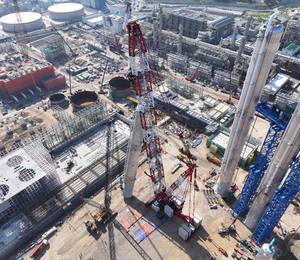Singapore’s National Environment Agency (NEA) announced today (30 Jul) that it will commence the next stage of Tuas Nexus Integrated Waste Management Facility (IWMF) Phase One development, comprising a 400 tonnes per day (tpd) Food Waste Treatment Facility (FWTF) and an 800 tpd Sludge Incineration Facility (SIF). The construction of these facilities will play a key role in realising Singapore’s vision of zero waste and circular economy.
Following an open tender process, NEA has awarded the engineering, procurement and construction (EPC) Package 2 contract to UES Holdings Pte Ltd (UESH) – China Harbour (Singapore) Engineering Company Pte Ltd (CHEC) Joint Venture, totalling S$428 million. According to NEA, the submitted proposals were evaluated based on their process design and optimisation, resource efficiency, Green Mark initiatives, plant layout and value for cost.
Tuas Nexus is Singapore’s first integrated water and solid waste treatment facility, which provides an innovative and sustainable solution to meet the country’s long-term solid waste management and used water treatment needs. The co-location of two mega facilities – NEA’s IWMF and PUB’s Tuas Water Reclamation Plant (Tuas WRP) – will optimise land use and improve energy and resource recovery from waste and used water.
Compared to existing standalone facilities, Tuas Nexus is expected to result in carbon savings of more than 200,000 t of CO2 annually, equivalent to taking 42,500 cars off Singapore’s roads, said NEA.
The Agency added that unlike existing waste-to-energy (WTE) plants, Tuas Nexus IWMF will adopt an integrated approach to process multiple waste streams, including food waste and sludge. This will increase resource and energy recovery while further reducing the environmental footprint and land use.
The 400 tpd FWTF and 800 tpd SIF, together with the 2,900 tpd WTE Facility and 250 tpd Materials Recovery Facility (which were awarded under a separate EPC contract in 2020), form the Tuas Nexus IWMF Phase One development. Phase One is expected to be completed in 2025.
Food waste and dewatered sludge treatments
When completed, IWMF’s FWTF will be Singapore’s primary facility for the treatment of source-segregated food waste. At the FWTF, inorganic materials will first be separated from food waste, explained NEA. The food waste fraction will then be turned into a slurry, which will be co-digested with used water sludge at the Tuas WRP. The co-digestion of food waste slurry and used water sludge will increase biogas production at the Tuas WRP and improve energy recovery from waste.
The biogas produced will be combusted at the IWMF to enhance its overall plant thermal efficiency and power production. The electricity generated by IWMF will be sufficient to sustain the operations of Tuas Nexus and excess electricity will be exported to the national grid. When fully operational, the amount of excess electricity exported to the grid by IWMF will be able to power up to 300,000 four-room HDB flats (Singapore’s public housing).
NEA further highlighted that the SIF at IWMF will also treat dewatered sludge generated from the Tuas WRP. This eliminates the need for Tuas WRP to truck the dewatered sludge to another location for treatment, thus reducing the carbon footprint.
The steam produced by the SIF will be used by Tuas WRP for its thermal hydrolysis process to pre-condition the used water sludges prior to anaerobic digestion, as well as for greasy waste treatment. The flue gas from the SIF will be treated in a wet scrubber for clean emissions.
Luke Goh, CEO of NEA said, “This next stage of the Tuas Nexus development focuses on integrating advanced facilities to treat food waste and sludge from PUB’s Tuas Water Reclamation Plant. Integration of these typically distinct treatment processes is complex but delivers the benefits of higher energy recovery and lower carbon emissions. This is part of Singapore’s push towards a circular economy where we optimise each stage of our waste management system in an environmentally friendly manner.”
Images: National Environment Agency (NEA)













